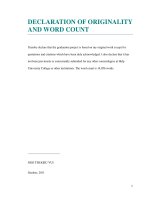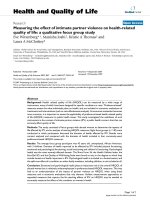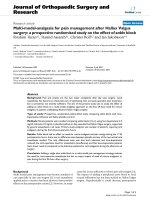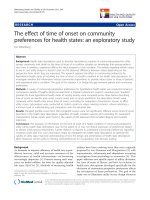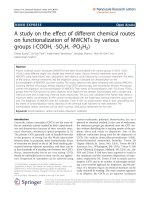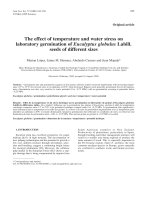Study on the effect of different pre-sowing seed treatment on seed quality of mustard (Brassica junecea L.)
Bạn đang xem bản rút gọn của tài liệu. Xem và tải ngay bản đầy đủ của tài liệu tại đây (204.12 KB, 7 trang )
Int.J.Curr.Microbiol.App.Sci (2019) 8(9): 26-32
International Journal of Current Microbiology and Applied Sciences
ISSN: 2319-7706 Volume 8 Number 09 (2019)
Journal homepage:
Original Research Article
/>
Study on the Effect of Different Pre-Sowing Seed Treatment on Seed
Quality of Mustard (Brassica junecea L.)
Y. Rahul Reddy*, Prashant Kumar Rai, A.K. Rai and Bineeta M. Bara
Department of Genetics and Plant Breeding, Naini Agricultural Institute, Sam Higginbottom
University of Agriculture, Technology and Sciences, Pryagraj, 211007 U. P., India
*Corresponding author
ABSTRACT
Keywords
Mustard, Priming
methods,
Characters, Gauss,
Treatments
Article Info
Accepted:
04 August 2019
Available Online:
10 September 2019
The experiment was conducted in Post Graduate Laboratory, Department of Genetics and Plant
Breeding, Sam Higginbottom University of Agriculture, Technology and Sciences, Prayagraj (U.P.)
during Rabi season 2018, in order to find out the suitable priming method for Mustard, for different
organic and inorganic viz., T0-Untreated (control), T1-DH2O-(12hrs), T2-KNO3-1% (12hrs), T3KNO3-1% (24hrs), T4-NaCl-1% (12hrs), T5-NaCl-1% (24hrs), T6-200gauss (30min), T7-400gauss
(30min), T8-100mA (30min), T9-200guass (30min), T10-neem leaf extract@5%-12hrs and T11-tulsi
leaf extract @5%-12hrs. The seeds were taken and hydrated in their solution for their respective time
duration and then dried for 12 hrs under shade. It was found that all the priming treatments showed
significance difference with the control while highest germination percentage, Field emergence,
Days to 50% flowering, Number of siliqua per plant, Number of seeds per siliqua, test weight (gm),
Seed yield per plant (gm), and seedling character parameters viz.., Germination percentage (%), Root
length (cm), Shoot length (cm), Seedling length (cm), Seedling fresh weight (gm), Seedling dry
weight (gm), Vigour index-I, Vigour index –II, Speed of germination were observed for seeds treated
with 200 gauss(30min) and plant height, number of primary branches per plant showed nonsignificant difference with control. The study helps to improve the seedling character, growth and
nodulation and seed yield with the help of seed priming treatments which are effective, economic,
non-toxic and eco-friendly sources.
tropical areas of the world. Globally, it is
mainly cultivated in India, Canada, China,
Pakistan, Poland, Bangladesh, Sweden and
France. About 35% area of the total cultivated
area of world is in India with 16% of shares in
production. Brassica juncea belongs to family
brassicaceae and is a very important oil crop.
Mustard oil is one of the major edible oils in
India. Mustard oil has also got medicinal
importance. Residual part of seeds is used as
cattle feed and in fertilizer. Indian mustard
(Brassica juncea L.) is a fast growing plant
which produces a high biomass even in heavy
Introduction
Mustard is a member of the cruciferace
family, which includes broccoli, cabbage,
Brussels sprouts, rapeseeds, field rape, canola,
Ethiopian mustard and black mustard. Indian
mustard (Brassica juncea) is a close relative to
canola (B. napus) and Ethiopian mustard (B.
campestrus). Edible oilseeds are playing an
important role in daily food basket of human
being. Mustard (Brassica juncea L.) is one of
the first domesticated crops in rabi season. It
is widely cultivated in tropical and sub26
Int.J.Curr.Microbiol.App.Sci (2019) 8(9): 26-32
metal polluted soils. Brassica oilseed crops,
Brassica juncea, B. napus and B. rapa, cover
more than 11 million hectares of the world's 6
agricultural land and provide over 8% of the
major oil when grown under a variety of
climatic conditions (Downey, 1990). The
annual production of Brassica juncea in India
reaches alone -ve million tons (FAO, 2003).
Mustard seed oil content varies from 35% to
46%.Mustard seed is the third leading source
of vegetable oil in the world after Soya bean
oil and palm oil. Mustard seed containing
about 40-50% protein. It is world's second
leading sources of protein meal after soybean
meal.
contributes to significant improvement in seed
germination and seedling growth in different
plant species. Similar to other priming
techniques, hydropriming generally enhances
seed germination and seedling emergence,
although there are exceptions. During priming,
seeds are partially hydrated so that pregerminative metabolic activities proceed,
while radical protrusion is prevented, and then
are dried back to the original moisture level.
Hence, present studies were undertaken to
assess the effect of different pre-sowing seed
treatments on germination and seedling vigour
of Mustard (Brassica juncea L.)
Materials and Methods
India is the fifth major mustard producing
country and fourth major mustard consuming
country in the world. The major mustard
growing states in India are Rajasthan, Uttar
Pradesh, Haryana, Madhya Pradesh, Gujarat
and West Bengal.
The experiment was conducted in post
graduate
Seed
Testing
Laboratory,
Department of Genetics and Plant Breeding,
Sam Higginbottom University of Agriculture,
Technology and Sciences, Pryagraj (U.P.), in
order to find out the best priming method for
Mustard. 1control and 10 treatments, viz..,
DH2O (12hrs), KNO3@1%(12hrs), KNO31%
(24hrs), NaCl@1%(12hrs), NaCl@1%(24hrs),
200guass (30min), 400guass(30min), 100mA
(30min), 200mA(30min), Neemleafextract-5%
(12hrs), Tulasi leaf extract-5%(12hrs) are used
to find best priming technique for mustard,
seeds were placed on petri plates (Top of the
paper method) for germination percentage and
speed of germination.
Rajasthan contributes about 49% to the
county’s total mustard production, followed
by Uttar Pradesh (11%), Haryana (11%),
Madhya Pradesh (11%), Gujarat (6%), West
Bengal (5%) and other districts (7%). Mustard
is grown for its oil rich seeds. Apart from
extracting oil, seeds are also used directly in
the preparation of almost all Indian curries
particularly in a process called “tadka”. India
occupies the first position both in area and
production of mustard.
Preparation of chemical solution
Seed priming is a technique to reduce
emergence
time,
accomplish
uniform
emergence time, better algometric (changes in
growth of plant parts over time) attributes and
provide requisite stand in many horticultural
and field crops. Various pre-hydration or
priming treatments have been employed to
increase the speed and synchrony of seed
germination (Bradford, 1986). Common
priming techniques include hydropriming,
halopriming osmopriming. Hydropriming
Chemical solutions, NaCl, KNO3 10 grams of
chemical were added with 1000 ml of water.
Preparation of germination media
Wet tissues were used as germination media
and Petridis was used as container. The
moisture content of the media was maintained
at 80% of field capacity.
27
Int.J.Curr.Microbiol.App.Sci (2019) 8(9): 26-32
seed quality parameters. In general, most of
the treatment was found effective in increasing
the yield attributes at all stages significantly as
compared to control. In the growth, yield
attributing parameters such as field
emergence, the maximum was recorded in T698.66 followed by T7- 96.33 and T11-94.00 and
the lowest was observed in T0-85.00 field
emergence was increased by 13% compared to
control. Days to 50% flowering, the maximum
was recorded in T6-39.33 followed by T1139.00 and T4-39.00 and the lowest was
observed in T0-36.00 days to 50% flowering
was increased by 4.33% compared to control.
plant height shows non-significant difference
compared to control, number of branches, the
maximum was recorded in T6-7.26 followed
by T11- 4.73 and T7-4.66 and the lowest was
observed in T0-3.6 number of branches was
increased by 4.20% compared to control,
siliqua per plant, the maximum was recorded
in T6-90.53 followed by T11- 65.6 and T7-64.33
and the lowest was observed in T0-48.06
number of siliqua per plant increased by 42%
compared to control, seeds per siliqua the
maximum was recorded in T6-8.82 followed
by T7- 8.78 and T3-8.78 and the lowest was
observed in T0-6.96 seeds per siliqua was
increased by 2% compared to control, test
weight, the maximum was recorded in T6-0.54
followed by T7- 0.52 and T11-0.48 and the
lowest was observed in T0-0.39 test weight
was increased by 0.15% compared to control.
seed yield, the maximum was recorded in T64.04 followed by T1- 2.65 and T7-2.63 and the
lowest was observed in T0-1.79 seed yield was
increased by 2.75% compared to control as
shown in the Table 1.
Yield and yield attributing characters
Plant height (cm), number of siliqua of ten
randomly selected plants, number of seeds of
10 randomly selected siliqua 10 each
treatment and replication were recorded at
maturity. Weight of total quantity of harvested
seeds per plot foe each treatment and
replication was recorded and the yield per
hectare was calculated and expressed in q/ha1.
Seed quality parameters
For seed quality assessment germination test
was conducted using the top paper method as
prescribed in ISTA rules (1996), by providing
the optimum conditions. The germination
count was made on normal seedlings and
expressed in per cent. Vigour indices were
computed by adopting the following formula
as suggested by Abdul Baki and Anderson
(1973) and expressed in number. Vigour Index
I = Germination (%) X Seedling length (cm)
Vigour Index II = Germination (%) X
Seedling dry weight (g).
Data analysis
The data obtained from different yield and
seed quality components were statistically
analyzed to find out the significance of the
difference among the treatments. The analysis
of variance (ANOVA) was performed RBD
and CRD.
Results and Discussion
It is evident from the present investigation that
different types of priming methods viz., DH2O
(12hrs), KNO3@1%12hrs, KNO3@1%24hrs,
NaCl@1%12hrs, NaCl@1%24hrs, 200 guass
(30min), 400guass (30min), 100mA (30min),
200mA (30min), neemleafextract@5%12hrs,
tulsi leaf extract@5%-12hrs have positive
effect on the growth, yield, yield attributes and
In seed quality parameters germination
percentage, the maximum was recorded in T698.50 followed by T7- 97.50 and T11-97.00 and
the lowest was observed in T0-85.00
germination percentage was increased by
23.50% compared to control, root length, the
maximum was recorded in T6-11.78 followed
28
Int.J.Curr.Microbiol.App.Sci (2019) 8(9): 26-32
by T7- 11.53 and T1-11.27 and the lowest was
observed in T0-8.61 root length was increased
by 2.17% compared to control, shoot length,
the maximum was recorded in T6-8.54
followed by T7- 8.03 and T9-7.77 and the
lowest was observed in T0-6.53 shoot length
was increased by 1.50% compared to control,
seedling length, the maximum was recorded in
T6-19.49 followed by T7- 19.28 and T10-18.25
and the lowest was observed in T0-15.34
seedling length was increased by 3.15%
compared to control, fresh weight, the
maximum was recorded in T6-0.7 followed by
T7- 0.53 and T3-0.53 and the lowest was
observed in T0-0.38 fresh weight was
increased by 23.50% compared to control, dry
weight of seedlings, the maximum was
recorded in T6-0.13 followed by T7- 0.12 and
T5-0.11 and the lowest was observed in T00.07 dry weight of seedlings was increased by
6 % compared to control, vigour index-1, the
maximum was recorded in T6-7679.06
followed by T7- 7083.91 and T11-6943.5 and
the lowest was observed in T0-5931.3 vigour
index-1, was increased by 21% compared to
control, vigour index-2, the maximum was
recorded in T6-55.72 followed by T7- 45.08
and T5-39.95 and the lowest was observed in
T0-29.25 vigour index-2was increased by 16%
compared to control, speed of germination the
maximum was recorded in T6-97.75 followed
by T7- 97.25 and T11-97.25 and the lowest was
observed in T0-85.25 speed of germination
was increased by 8% compared to control,
shown in Table 2.
Table.1 Mean performance of mustard for growth, yield and yield attributes
Sl.
NO
Treat
ments
1
T0
2
T1
3
T2
4
T3
5
T4
6
T5
7
T6
8
T7
9
T8
10
T9
11
T10
12
T11
GRAND
MEAN
CD(5%)
SEm±
CV
Field
Emergence
Plant
height
85.00
93.00
90.66
82.00
87.66
91.66
98.66
96.33
93.00
87.66
92.00
94.00
90.97
Days to
50%
Flowering
36.00
37.66
37.33
36.33
39.00
36.66
40.33
39.33
38.66
38.33
38.00
39.00
38.05
No. of
siliqua
per plant
48.06
59.26
60.33
64.4
50.66
58.8
90.53
64.33
62.33
53.2
55.26
65.6
61.06
No. of
seeds per
siliqua
6.96
8.72
8.52
8.78
8.71
8.51
8.82
8.78
8.69
8.25
8.49
8.61
8.49
Test
weight
85.2
96.73
89.66
91.93
98.4
95.53
98.66
97.46
94.53
92.53
96.66
98.86
94.68
No. of
Branches
per plant
3.6
4.06
4.00
3.86
3.73
4.4
7.26
4.66
3.93
3.8
4.66
4.73
4.39
0.39
0.47
0.42
0.45
0.45
0.43
0.54
0.52
0.42
0.48
0.46
0.48
0.45
Seed yield
per plant
(gm)
1.79
2.65
2.40
2.56
2.53
3.24
4.04
2.63
2.46
1.82
2.21
2.63
2.55
7.89
2.69
5.1
3.96
1.35
6.1
19.27
6.57
12.0
1.64
0.56
22.1
20.26
6.91
19.6
0.87
0.30
6.0
0.06
0.02
7.8
0.96
0.33
22.2
29
Int.J.Curr.Microbiol.App.Sci (2019) 8(9): 26-32
Table.2 Mean performances of mustard for seed quality parameters
Sl.
No
Treatment
T0
1
T1
2
T2
3
T3
4
T4
5
T5
6
T6
7
T7
8
T8
9
T9
10
T10
11
T11
12
GRAND MEAN
CD(5%)
SEm±
Germination Root
Shoot
Seedling Fresh Weight Dry Weight Seed
Seed
percentage
Length Length Length of Seedling (g) of Seedling Vigour Vigour
(cm)
(cm)
(cm)
(g)
Index 1 Index 2
85.00
8.61
6.53
15.34
0.38
0.07
5931.3
29.25
96.00
11.27
7.54
17.55
0.64
0.10
6740.16
33.77
87.5
8.65
6.78
15.51
0.44
0.08
5369.87
30.62
85.5
9.09
6.67
15.59
0.53
0.10
5334.34
35.91
89.00
11.25
7.37
18.39
0.41
0.09
6547.73
29.71
96.5
9.29
7.33
17.44
0.60
0.11
5989.75
39.95
98.50
11.78
8.54
19.49
0.7
0.13
7679.06
55.72
97.50
11.53
8.03
19.28
0.53
0.12
7083.91
45.08
88.00
10.76
7.14
17.93
0.39
0.08
6314
29.92
85.00
8.86
7.77
17.73
0.47
0.10
6029.05
36.55
90.00
10.33
7.45
18.25
0.49
0.09
6061.57
37.83
97.00
9.08
6.91
15.54
0.45
0.08
6943.5
37.8
91.29
10.04
7.34
17.34
0.50
0.10
6335.35
36.843
7.516
2.256
1.007
2.536
0.1656
0.036
235.78
3.22
2.62
0.786
0.351
0.884
0.057
0.012
82.20
1.125
30
Speed
of
Germination
85.25
95.00
92.75
76.25
89.5
89.75
97.75
97.25
87
85.25
96.25
97.25
91.72
9.848
3.433
Int.J.Curr.Microbiol.App.Sci (2019) 8(9): 26-32
The magnetic field mechanisms of action on
plants germination and seedling growth is not
well known yet, however several theories
have been proposed, including biochemical
changes or altered enzyme activities. Seed
germination stimulation might be attributed to
a combined effect
of biochemical,
physiological, metabolic as well as enhanced
enzymatic action.
and armed with knowledge of safe limits for
soaking, time of exposure of magnetic and
electric fields and evaluate the trails during
farm walks and group discussion. On farm
seed priming is a key technology low cost
with low risk to produce an immediate
benefit, unlocking the farming system and
giving the farmer reasonable access to further
benefits.
It is assumed that the magnetic field treatment
influences the structure of cell membrane and
in this way increase their permeability and ion
transport in the ion channels, which as a result
affects the metabolic pathways. The enzymes
which are necessary for seed germination at
particular stages of germination were found
higher in magnetically treated seeds during
seed germination. The magnetic field affects
the biological objects by non-conventional
spins, free radicals, liquids crystals or mobile
electron charges. Chemically these free
radicals are very active species, which take
part in fast reactions and cause changes in the
biochemical and physiological processes
during seed germination and an increase in
water uptake rate due to magnetic field
treatment was found, which may be
responsible for increased pea seed
germination as well as seedling growth and at
lateral stages of development (Labes, 1993;
Podleœny et al., 2004; Wards, 1978).
References
Abdul-Baki, A. A. and Anderson, J. D.
(1973). Vigour determination in
soybean by multiple criteria. Crop
Science, 13: 630-633.
Afzal I, Ashraf S, Qasim M, Basra SMA,
Shahid M. Does halopriming improve
germination and seedling vigour in
marigold (Tagetes spp.) Seed Science
Technology. 2009; 37: 436-445. 2.
Afzal I, Basra SMA, Ahmad N, Cheema MA,
Warraich EA, Khaliq A Effect of
priming and growth regulator treatment
on emergence and seedling growth of
hybrid maize (Zea mays). Int. J. Agric.
Biol. 2002; 4: 303- 306. 3.
Amarnath, B. H. Chaurasia A.K, Arvind K.
2013. Effect of priming with botanicals
and animal waste on germination and
seedling vigour in sorghum (Sorghum
bicolor L) seeds Advances in Research,
2015, 6(10):73-77.
Anna, A. 2002. Study of the influence of
magnetic field on some biological
characteristics of Zea mays. Journal of
Central European Agric. 3: 89-94.
Applied Science Deepti, P., Negi, S. 2015.
Effect of Seed Priming with Some Plant
Leaf Extract on Seedling Growth
Characteristics and Root Rot Disease in
International Journal of Agriculture
System (1JAS) Tomato. 4(1):132-135.
Arif M, Jan MT, Marwat KB, Khan MA.
Seed priming improves emergence and
yeild of Soybean. Pak. J. Bot, 2007;
On the basis of experimental results it may be
concluded that better growth and yield was
observed in T6 (200guass@30min) and
superior than control followed by T7
(400guass@30min) and T11 (tulasi leaf extract
@ 5% at 12hrs) significantly increased the
quality parameters and yield attributes of
mustard. From the present investigation i
suggest that magneto priming is suitable
priming technique for mustard, it is ecofriendly and economic in use. I suggest the
on-farm trails to popularize this concept. Onfarm trails means some farmers are selected
31
Int.J.Curr.Microbiol.App.Sci (2019) 8(9): 26-32
40(3): 1169-1177. 4. The sweet corn
seeds harvested at different times.
Bragantia. 65(4): 687-692.
Asharf M. and Foolad M.R., (2005) Presowing treatment- a shotgun approach
to improve germination growth and
crop yield under non-saline condition.
Advance Agronomy. 88: 223 271.
Basra, S. M. A., Zia, M. N., Mahmood, T.,
Afzal, I. and Khaliq, A., (2003)
Comparison of different invigoration
techniques in wheat (Triticum aestivum
L.) seeds. Pakistan Journal of Arid
Agriculture, 2:11-16.
Bhatnagar, D. and Deb, A.R. 1977. Some
aspects of pre-germination exposure of
wheat seeds to magnetic fields. Seed
germination and early growth. Seed
Res. 5: 129-137
Bovy A, de Vos R, Kemper M, et al., Highflavonol tomatoes resulting from the
heterologous expression of the maize
transcription factor genes LC and C1.
Canene-Adams K, Campbell JK, Zaripheh S,
Jeffery EH, Erdman Jr JW. The tomato
as a functional food. Journal of
Nutrition 2005; 135: 1226-1230. 6.
How to cite this article:
Rahul Reddy, Y., Prashant Kumar Rai, A.K. Rai and Bineeta M. Bara. 2019. Study on the
Effect of Different Pre-Sowing Seed Treatment on Seed Quality of Mustard (Brassica junecea
L.). Int.J.Curr.Microbiol.App.Sci. 8(09): 26-32. doi: />
32
